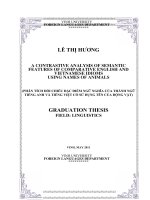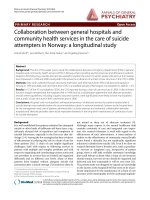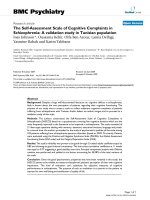Incidence of ophthalmic affections in dogs – A short study
Bạn đang xem bản rút gọn của tài liệu. Xem và tải ngay bản đầy đủ của tài liệu tại đây (237.12 KB, 6 trang )
Int.J.Curr.Microbiol.App.Sci (2018) 7(9): 1560-1565
International Journal of Current Microbiology and Applied Sciences
ISSN: 2319-7706 Volume 7 Number 09 (2018)
Journal homepage:
Case Study
/>
Incidence of Ophthalmic Affections in Dogs – A Short Study
Tarun Kumar1*, Manisha Punia2, Divya Agnihotri1, Neelesh Sindhu1 and V.K. Jain1
1
Veterinary Clinical Complex, L2Department of Veterinary Medicine, Lala Lajpat Rai
University of Veterinary & Animal Sciences, Hisar-125004 (Haryana) India
*Corresponding author
ABSTRACT
Keywords
Eye affections, Dog,
Pigmentary keratitis
Article Info
Accepted:
10 August 2018
Available Online:
10 September 2018
Ophthalmic affections in dogs reported in Veterinary Clinical Complex, LUVAS,
Hisar were investigated for a period of one year. The occurrence of different
ophthalmic conditions was analysed in different affected age group, sex and breed of
dogs. Out of total 4500 clinical cases of dogs (60) sixty cases of ocular affections were
reported with maximum incidence of Pigmentary Keratitis and Corneal Ulcer/Eye
Injury. Pugs, non-descript breeds and Labrador recorded highest incidence of ocular
affections with maximum cases in young age group.
Introduction
Eye is very sensitive organ, the function of
which may be affected even with mild insult
to its homeostasis, due to direct injury or due
to other local or systemic diseases and hence
studies on ocular affections may provide
information on prevalence of ocular diseases
and also help to limit diagnostic possibilities
and treatment options (Andrade et al., 2005,
Balagopalan et al., 2016). Hence the objective
of the present study was to record incidence
and pattern of distribution of various types of
ocular affections in dogs of this area. Ocular
affections are of common occurrence in
animal patients and their diagnosis and
management throws up a challenge for the
veterinarians unless they are adequately
equipped with instrumentation and sound
knowledge to deal with these affections. In
India ophthalmology remains the domain of
general veterinary surgeon, therefore with few
exceptions, the important field remains more
or less neglected. So this study was planned to
assess the magnitude of ocular problems in
dogs in this part of the country and their
management.
Materials and Methods
The study was conducted to find out the
occurrence of ocular affections with respect to
breed, age and sex of animal and type of
affections in dogs brought to the Veterinary
1560
Int.J.Curr.Microbiol.App.Sci (2018) 7(9): 1560-1565
Clinical Complex (VCC), LUVAS, Hisar
during a period of one year (July 2017 to June
2018). General clinical examination and
detailed ophthalmic examination with direct
and indirect ophthalmoscopy along with
schirmer tear test and tonometery was
performed to diagnose the conditions.The
incidence of different ocular affections with
reference to age, breed and sex were recorded
and analyzed.
Results and Discussion
During a period of one year, a total of four
thousand five hundred (4500) clinical cases of
dogs having different clinical affections were
reported at VCC, LUVAS-Hisar, out of which
sixty (60) dogs were presented with
ophthalmological complaints. Incidence of eye
affections in dogs was found to be 1.33%. Out
of 60 dogs with ocular affections, 39 (65%)
were male and rest 21 (35%) were female
(Table 1). Majority of the ophthalmic
affections were recorded in younger age group
i.e. 0-3yrs age group (51.7%) followed by 36yrs (36.7%) and 6-9yrs (11.6%) (Table 2)
which may be attributed to the playful nature
of young ones which make them more prone
to traumatic injuries and excessive attention
resulted into more presentation in the clinics
for veterinary care. Breed wise distribution of
cases (Table 3) showed maximum prevalence
of eye affections in Pugs (28.3%) followed by
Non-descript breeds (21.7%) and Labrodor
(20%). Ocular affections were also reported in
other breeds like Spitz (15%), German
Shepherd (11.7%) whereas Bully breed had
the least incidence (3.3%) of ocular affections.
Depending on the type of lesions ocular
affections were divided into different
categories (Table 4). Out of total Sixty (60)
reported cases, maximum cases were of
Pigmentary Keratitis/ Keratoconjunctivitis
(21.7%) and of Corneal Ulcer/Injury (21.7%)
followed by Corneal Opacity (18.3%),
Epiphora (11.6%) and Cloudy eye (8.3%).
Cataract and Blepharitis showed 6.7% of
occurrence along with dry eye (5%) reported
during the study period. Breed wise data
revealed
that
Pigmentary
Keratitis/
Keratoconjunctivitis was more common in
pugs whereas Corneal Injury was recorded
maximum in non-descript breeds and pugs.
Incidence of corneal opacity and cataract was
higher in Labrador and German Shepherd
dogs. Interestingly present study recorded
maximum cases of ocular affections in Pugs
and clinical categorization too revealed
majority of the cases were of Pigmentary
Keratitis/ Keratoconjunctivitis.
Present report of ophthalmic affections in dogs
from this part of the country is first of its type
and it includes one-year data. With the
incidence of ocular affections to be 1.33% in
the present study it was observed that dogs
presented with ocular affections are increasing
with time in this institution probably due to
increase in awareness on the part of dog
owners in this area as well as increase in use
of
advanced
diagnostic
aids
like
ophthalmoscopes, tonometers and other
specific diagnostic tests. Akinrinmade and
Ogungbenro in 2015 reported 6.62% incidence
of eye affection in dogs from Nigeria between
2003 and 2013, whereas Tyagi in 2009
recorded 8.96% incidence of eye infections in
dogs, which is higher as compared to the
present findings. The sex wise distribution of
ocular affections is contrary to the findings of
Akinrinmade and Ogungbenro (2015) as they
reported more eye infections in females
(42.42%) as compared to males (35.49%).
Tamilmahan et al., (2013) and Antonia et al.,
(2014) recorded similar findings as of the
present study with maximum incidence of eye
diseases in male dogs as compared to female.
The reason could be preference for male dogs
as pets in the particular area and their
increased socializing behaviour than the
female dogs (Fig. 1 and 2).
1561
Int.J.Curr.Microbiol.App.Sci (2018) 7(9): 1560-1565
Table.1 Sex wise distribution of ocular affections
Sex
Number
Percentage
Male
39
65%
Female
21
35%
Table.2 Age wise prevalence of ocular affections
Age group
Number
Percentage
0-3yrs
31
51.7%
3-6yrs
22
36.7%
6-9yrs
7
11.6%
Table.3 Breed wise prevalence of ocular affections
Breeds
No. of dogs
Percentage
Pug
17
28.3%
Non-descript
13
21.7%
Labrador
12
20%
Spitz
9
15%
German shepherd
7
11.7%
Bully
2
3.3%
Table.4 Incidence of common ocular affections during July2017 to June 2018
Affections
Number
Percentage
Keratitis (pigmentary) / Keratoconjunctivitis
Corneal Ulcer/Injury
13
13
21.7%
21.7%
Corneal Opacity
11
18.3%
Epiphora
7
11.6%
Cloudy eye
Cataract
5
4
8.3%
6.7%
Blepharitis
4
6.7%
Dry Eye
Total
3
60
5%
100%
1562
Int.J.Curr.Microbiol.App.Sci (2018) 7(9): 1560-1565
Fig.1 Keratoconjunctivitis in pug
Fig.2 Eye cataract in Labrador
Age wise distribution of ocular affections
showed majority of opthalmic affections in
younger age group i.e. 0-3yrs age group
(51.7%). Akinrinmade and Ogungbenro
(2015) recorded similar findings and they
documented (90.47%) cases in dogs less than
5 years of age whereas Tyagi (2009) and
Tamilmahan et al., (2013) both reported
increased incidence of eye cases in dogs more
than 5 years of age. The higher incidence in
younger age group in the present study may
be attributed to the playful nature of young
ones which make them more prone to
traumatic injuries and excessive attention
resulted into more presentation in the clinics
for veterinary care.
Contrary to our findings of breed wise
distribution of cases of ocular affections,
Akinrinmade and Ogungbenro (2015)
reported Alsatian to be the most affected
breed (22.08%), but from India many authors
like Sarangom et al., (2012), Ramani et al.,
(2012) and Antonia et al., (2014) reported
Chinese Pugs as the most affected breed. This
may be due to more popularity of this breed in
this region as well as anatomical peculiarities
that make this breed more prone to ocular
affections.
Out of total Sixty (60) reported cases,
maximum cases were of Pigmentary Keratitis/
Keratoconjunctivitis (21.7%) and of Corneal
1563
Int.J.Curr.Microbiol.App.Sci (2018) 7(9): 1560-1565
Ulcer/Injury (21.7%) followed by Corneal
Opacity (18.3%), Epiphora (11.6%) and
Cloudy eye (8.3%). Clinical categorization by
Akinrinmade and Ogungbenro (2015)
revealed highest incidence of conjunctivitis
(30.30%), followed by proptosis/edema/
swelling of the eye (22.94%) and corneal
opacity (11.69%), whereas Sale et al., (2013)
and Tyagi (2009) reported age-related cataract
as most common ocular affection in dogs.
Although Kalaiselvan et al., (2009) reported
traumatic injuries as the major causes of
ocular affections.
Breed wise data revealed that Pigmentary
Keratitis/ Keratoconjunctivitis was more
common in pugs whereas Corneal Injury was
recorded maximum in non-descript breeds
and pugs. Incidence of corneal opacity and
cataract was higher in Labrador and German
Shepherd dogs.Interestingly present study
recorded maximum cases of ocular affections
in Pugs and clinical categorization too
revealed majority of the cases were of
Pigmentary Keratitis/ Keratoconjunctivitis.
This higher incidence could be due to its
brachiocephalic nature with protruded eye
ball making the eye exposed to different
allergens, dust particles etc. Apart from this
abnormal tear film composition may also be
one of the reason for pugs susceptibility as
suggested by Krency et al., (2015).
Based on the results of the present study, it
can be concluded that Keratoconjunctivitis
and corneal injury are the two important
ocular affections in dogs of this region with
maximum cases in Pug and Non-descript
breed. Further studies need to be undertaken
to investigate the detailed aetiology of ocular
abnormalities in pugs and other breeds with
therapeutic management.
Acknowledgement
Dean COVS and HOD VCC, LUVAS-Hisar
References
Akinrinmade, J.F and Ogungbenro, O.I. 2015.
Incidence, diagnosis and management
of eye affections in dogs. Sokoto
Journal of Veterinary Sciences. 13(3):
9-13
Andrade, S.F., Goncahes, I.N. and Junior,
M.M.A. 2005. Evaluation of Schimer
tear Test with the use of melting filter
paper prudente. Clinica-Veterinaria.
10(55): 34-36.
Antonia, N. A., Narayanan, M. K., Anoop, S.,
Devanand, C. B., Martin, J., K. D. and
Venugopal, S. K. 2014. Occurrence of
ophthalmic disorders in dogs. Indian J.
Vet. Res. 23 (2): 21-24.
Balagopalan, T.P., Aruljothi, N., Alphonse,
R.M.D. and Ramesh, K. B. 2016.
Ocular Affections in Cattle - A Clinical
Retrospective
Study.
IntasPolivet.
(17)2: 345-347.
Kalaiselvan, A., Pawde, A.M., Kinjavdekar,
P., Amarpal, H., Aithal, P. and Gupta,
O.P.2009. Occurrence of ocular
affections in domestic animals. Indian
Journal of Animal Science, 79(10):
1020.
Krecny, M., Tichy, A., Rushton, J. and Nell,
B. 2015. A retrospective survey of
ocular abnormalities in pugs: 130 cases.
Journal of Small Animal Practice. 56:
96–102.
Ramani, C., Ahirwar, M. K., Shafiuzama,
M.d. and Nagarajan, L. 2012. Incidence
of corneal ulcer in dogs – a
retrospective study. Tamil Nadu J.
Veterinary & Animal Sciences 8 (5):
250-252.
Sale, M., Jhala, S.K., Parikh, P.V., Patil, D.B.,
Joy, N. and Ranpariya, J.J. 2003.
Incidence of ophthalmic infections in
dogs (2004-2013). Indian Journal of
Veterinary Surgery, 34(1): 61-62.
Sarangom, S. Evaluation and management of
eye affections in Chinese Pugs. 2012.
1564
Int.J.Curr.Microbiol.App.Sci (2018) 7(9): 1560-1565
MVSc. Thesis. Kerala Veterinary and
Animal Sciences University, Pookode.
166p.
Tamilmahan, P., Zama, M. M. S., Pathak, R.,
Muneeswaran, N. S. and Karthik, K.
2013. A retrospective study of ocular
occurrence in domestic animals: 799
cases. Veterinary World 6(5): 274-276.
Tyagi, S.P. 2009. Studies on the incidence,
diagnosis and management of eye
affections in dogs. Indian Journal of
Veterinary Surgery. 30(1): 26.
How to cite this article:
Tarun Kumar, Manisha Punia, Divya Agnihotri, Neelesh Sindhu and Jain, V.K. 2018.
Incidence of Ophthalmic Affections in Dogs – A Short Study. Int.J.Curr.Microbiol.App.Sci.
7(09): 1560-1565. doi: />
1565









